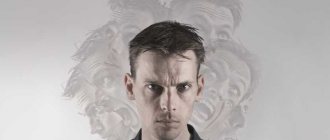Medical information is reliable Checked by Shaidullin Renat Flyurovich
Schizoaffective disorder is an endogenous mental disorder, the symptoms of which simultaneously resemble the symptoms of both schizophrenia and affective psychoses. It is characterized by impaired thinking and unregulated emotions. May include disorganization of speech, hallucinations, and paranoid delusions. The diagnosis of the disease is made based on observation if a person has simultaneously signs of bipolar disorder, depression and schizophrenia, but there are no clear criteria for each of these deviations. The pathology usually manifests itself at a young age and is treated by a psychiatrist.
Causes of schizoaffective disorder
The exact causes of the pathology are unknown, like many other mental disorders, but there are several individual characteristics of the body that increase the likelihood of developing schizoaffective disorder. Most often it is observed in individuals with a hereditary predisposition.
Researchers have identified a risk gene that causes the development of schizophrenia. But under certain conditions, it is in a “dormant state” and begins to manifest itself after exposure to severe stress, severe somatic illness, etc. In addition, the appearance of this gene in the fetus may be due to mutational processes. There is also an assumption of the etiological and pathogenetic similarity of this disease and epilepsy, since in both cases there is a periodicity of manifestations and characteristic changes in the electrical activity of the brain on the EEG.
Provoking factors for the development of schizoaffective disorder can be:
- low social status;
- hunger and poverty;
- hostilities;
- forced migration;
- complete loneliness and lack of help from other people;
- alcohol and drug use.
In the case of the use of psychoactive drugs and alcohol, the possibility of developing this mental disorder increases. At the same time, people with this pathology also often have chemical dependencies, with the help of which they try to get away from their painful sensations, but this only aggravates the process of degradation. To determine what is primary – a mental illness or an addiction to alcohol or drugs, an experienced specialist and monitoring of the patient’s condition in a psychiatric hospital are required.
Dr. Isaev’s clinic has all the conditions for conducting differential diagnosis and providing professional assistance for schizoaffective disorder. For more detailed information, you just need to call the number listed on the website.
Types of Schizoaffective Disorder
Depending on the predominance of a particular clinical picture, the following types of shazoaffective disorder are distinguished:
- manic;
- depressive;
- mixed;
- unknown etiology;
- other types of deviation.
The manic type is difficult, and the prognosis is often unfavorable. Such a person poses a danger during an exacerbation period and requires placement in a psychiatric ward. The depressive form of the disorder resembles prolonged or moderate clinical depression. In the mixed type, signs of schizophrenia and a picture of affective disorders are noted. Symptoms of schizoaffective disorder begin with the pre-manifest stage, then the attack itself is observed, and after that a remission of varying duration occurs. On average, the acute period lasts for 6-8 months.
Any form of schizoaffective disorder requires timely help. If such a problem has arisen in your family, call us and an experienced specialist will tell you what can be done in this case.
Schizoaffective disorder: symptoms
The first symptoms of this mental disorder are usually observed in adults; children, as a rule, do not suffer from it; the pathology is more often described in women. The first attacks, reminiscent of schizophrenia, alternate with affective manifestations and delusions, while relatively preserved social adaptation and ability to work are observed. Sometimes, at first, emotional disturbances come first, which are replaced by delusions and hallucinations. In some cases, deviations occur simultaneously, and then diagnosis does not cause difficulties.
Schizoaffective disorder refers to transient conditions of an endogenous nature. In this case, disturbances of the emotional type prevail over productive symptoms. The attack is characterized by significant polymorphism of manifestations; its structure includes depressive-paranoid and manic-paranoid types of attack.
The main symptom accompanying schizoaffective disorder is frequent changes in the patient's mood. This happens suddenly, unpredictably and cannot be controlled. After that, attention deficit disorder, hallucinations, and a person’s ability to control their behavior are added to the overall picture. He ceases to understand the difference between reality and his own far-fetched illusions; imagination begins to play the leading role. The disease can manifest itself as pronounced deviations that become noticeable to everyone around, or it can occur in an erased form, when the changes are visible only to those close to you. Typically, schizoaffective disorder is accompanied by the following symptoms:
- depression;
- depression;
- loss of appetite;
- change in body weight;
- addiction to drinking alcohol;
- disturbance of the alternation of sleep and wakefulness;
- lack of interest in what is happening around;
- weakness, loss of strength;
- self-flagellation, decreased self-esteem;
- decreased concentration;
- lack of control over thoughts and actions;
- inadequate emotional reaction;
- suicidal tendencies, thoughts of death;
- strange behavior.
A person with schizoaffective disorder suffers from hallucinations, stops performing simple hygiene procedures, and develops obsessive ideas. The acceleration of thought processes leads to the fact that speech becomes fast, words seem to be layered on top of each other, endings are swallowed.
When the first signs of schizoaffective disorder appear in a loved one, you should not expect the problem to solve itself. The sooner you seek help, the more effective the therapy will be.
In depressive-paranoid types of attacks, the pathology manifests itself in the form of decreased mood and delusions of self-deprecation, ideas of poisoning, destruction, the presence of a fatal incurable disease, and sinfulness. A person suffers from apathy, depression, insomnia. A severe form of the seizure is manifested by depressive oneiroid or stupor. Depressive attacks, if left untreated, can result in the development of addiction or attempted suicide.
The manic form of the attack is accompanied by a decreased need for sleep, unbridled joy, agitation that does not correspond to the situation, and ideas of one’s own importance and greatness. With severe psychosis, delusions of fantastic content and other productive schizophrenia-like symptoms appear. There is a decrease in concentration, increased energy, and inappropriate social behavior due to disinhibition of the nervous system. Clinical manifestations do not appear immediately, but gradually increase in intensity. Sometimes there are ideas of persecution and pronounced aggressiveness, in which a person begins to pose a danger to those around him.
Mixed states represent frequent fluctuations from hypomania and mania to depression. These affects are accompanied by delusions, which contain the theme of the struggle between good and evil with auditory hallucinations of a positive and negative type. They are contradictory and often mutually exclusive in meaning. The mixed type of schizoaffective disorder manifests itself in the form of alternating depressive-paranoid and manic-paranoid disorders (happiness-fear psychosis).
During the period of remission, a person does not have an emotional-volitional defect; after an acute attack, residual symptoms of schizophrenia or affective deviations persist for some time.
Diagnostic criteria for schizophrenia according to ICD-10
Currently, Russian and European psychiatrists, when diagnosing schizophrenia, are guided by the internationally recognized diagnostic criteria for schizophrenia set out in the International Classification of Diseases, 10th revision (ICD-10) (Mental and behavioral disorders).
According to ICD-10, to diagnose schizophrenia, it is necessary to have at least one clear symptom (or 2 less clear symptoms), related mainly to the signs of hallucinatory-paranoid syndrome, or 2 symptoms related to other symptoms (hallucinations, disorganized thinking , manifestations of catatonia, negative symptoms), which should be observed for at least a month.
Diagnostic symptoms of schizophrenia (ICD-10)
- Echo of thoughts, putting or taking away thoughts, broadcasting or openness
- Delusions of influence, influence, or mastery relating to movements of the body, limbs, thoughts, actions, or sensations; delusional perception
- Hallucinatory “voices” commenting on the patient’s behavior or discussing it among themselves; other types of hallucinatory voices coming from a part of the body
- Persistent delusional ideas of a different kind, which are not adequate for a given social culture and do not have a rational explanation for their content
- Persistent hallucinations of any kind, accompanied by unstable or incompletely formed delusional ideas without a clear emotional resonance, or constant overvalued ideas that can appear daily for several weeks;
- Interruption of thinking processes or “interfering” thoughts, which can lead to fragmentation or diversity in speech, the appearance of neologisms
- Catatonic disorders, such as undifferentiated, in some cases stereotypic arousal, impulsive actions, rigidity or waxy flexibility, negativism, mutism, stupor, exaggerated mannerisms, grimacing are possible
- “Negative” symptoms, such as marked apathy, poor speech, flattened or inappropriate emotional reactions, which usually leads to social withdrawal and decreased social productivity, and these signs should not be due to depression or drug exposure (neurolepsy)
- Significant progressive qualitative change in behavior, manifested by loss of interests and lack of focus. Inactivity, absorption in one’s inner world and social withdrawal.
As can be seen from the diagnostic criteria for schizophrenia presented above, great importance for the diagnosis of schizophrenia (ICD-10) is given to productive symptoms. When listing the diagnostic criteria for negative symptoms, there are symptoms that partly repeat each other, for example, such as social withdrawal and social withdrawal. Great importance is given to the time interval for the existence of symptoms of the disease.
If the patient’s condition meets the above criteria, but lasts less than a month, regardless of whether the patient received treatment or not, then according to ICD-10 it should be classified as acute schizophrenia-like psychotic disorder and recoded if the symptoms persist for a longer period.
According to DSM-1V, to make a diagnosis of schizophrenia, symptoms must be present for at least 6 months. During this time, a picture of psychosis with more than two characteristic symptoms of this disease must be observed for at least one month.
Symptoms of schizophrenia must be present for a sufficiently long time, cannot be explained by substance abuse or neurological disease, and observation of patients shows a noticeable decrease in social activity.
Signs of affective disorders
Clinical symptoms of schizoaffective disorder include mood disturbances and schizophrenic features. The degree of their expression is approximately the same, while they alternate or are observed simultaneously. Deviations of an emotional nature are:
- manic;
- depressed;
- agitated.
During mania, a person feels a surge of energy and strength, is always in a great mood, even to the point of euphoria, and is constantly busy doing something. His thinking speeds up greatly and he has difficulty trying to concentrate on a specific job, and problems with concentration arise. His speech becomes fast and incomprehensible due to constant jumping from one topic to another. The patient feels able to “move mountains.”
One of the variants of mania is increased irritability and anger. The person becomes aggressive, behaves rudely with other people, is rude, interrupts, and counteracts. Often this state accompanies the delirium of saving humanity from an alien invasion or another fictitious global problem of the world level.
When depressed, the patient loses his appetite, and sometimes he does not even have the strength to get out of bed. The pace of thinking processes slows down, a person feels melancholy and engages in self-flagellation, and does not find any sources of joy in life. If help is not provided in time, then during this period the likelihood of suicide greatly increases. A subtype of depression is considered to be agitation, when the patient’s sharply depressed mood is masked by active and unproductive activity, which is chaotic in nature.
Symptoms of Bipolar Affective Disorder
Symptoms of bipolar disorder include episodes of depression, mania, hypomania, and mixed (manic-depressive) episodes. Variations of certain conditions in bipolar disorder can be varied, including the intensity of manifestations of symptoms of bipolar disorder, the course of the disease, and changes in episodes. At the same time, depression and mania in the clinical sense are understood as opposite “peak” affective states.
Symptoms of bipolar disorder at the initial stage usually remain unrecognized both by the person himself and his loved ones. They can be attributed to character traits, lifestyle, or periods of life. But, ultimately, the disease inevitably leads to a deterioration in the quality of life, problems in the family and in society.
Today, in clinical practice, it is customary to distinguish six main types of bipolar affective disorder. However, we can talk about bipolar disorder in the strict sense of the word only if there has been at least one confirmed of the above episodes in the past. In this case, repeated episodes of only mania or hypomania are classified as bipolar.
Rice. 3. Types of the course of bipolar affective disorder with leading symptoms (“peak” - episodes of depression, mania) in the clinical picture.
Signs of a depressive episode
Depressive episodes in bipolar disorder are dangerous. They can last quite a long time (from 6 months), occur with regular frequency (for example, with an ultra-rapid change of episodes), and be of varying “depth”, including with insufficient recovery in dysthymic temperament. Thus, depending on personality traits, external factors and the threshold of resistance to stress, depressive episodes can cause suicidal tendencies.
A feature of depressive episodes in bipolar affective disorder is the factor of “expectation” of its occurrence, their regularity. When recovering from a depressive state, the feeling of “falling out” from reality and the fear of the onset of another episode in the future persist for some time.
Typical signs of bipolar affective disorder in the depressive phase include:
- nervousness;
- "ennui";
- anxiety for no apparent reason;
- feeling of helplessness, guilt “for no reason”;
- depressed, depressed mood;
- isolation, reluctance to communicate with other people;
- problems with concentration;
- a feeling of unreality of what is happening, “life is like a fog”;
- lack of appetite or noticeably decreased appetite;
- “24-hour” drowsiness or, on the contrary, insomnia;
- physical malaise, “constant loss of strength”;
- lack of physical desire, decreased libido;
- pessimistic thoughts and statements;
- suicidal tendencies.
Unlike depression as such, depressive episodes in bipolar disorder are a powerful destabilizing factor. They “burst” into a person’s life and disrupt its usual course. At the same time, depressive episodes do not necessarily arise abruptly or unexpectedly; a person can “anticipate” them, having a long experience of self-observation and realizing the consequences of the increasing deterioration of the psycho-emotional state.
Rice. 4. Dynamics of growth of depressive disorders in the world.
Signs of a manic episode
The symptoms of bipolar disorder that occur during a manic episode are the starting point for the romanticization of the disease in the modern world. They are associated with unusual productivity, flexibility of thinking and euphoria that changes the perception of reality. However, manic episodes, like depressive ones, can cause rash decisions, conflicts in the family, at work and in society (the awareness of the real consequences of what was said or done during this period comes only after leaving the episode).
Symptoms of bipolar personality disorder that characterize a manic episode include:
- state of euphoria;
- excessive self-confidence;
- feeling of “a surge of strength”;
- “fast flow of thoughts”;
- feeling of “internal tension”;
- anxiety without objective reasons;
- conflict, irritability;
- painful egocentrism;
- decreased need for sleep;
- increased libido.
Unlike a disease in which depressive episodes are observed, bipolar disorder with only manic episodes may not present discomfort (at the initial stage) for a person who has learned to live with “positive” surges in the psycho-emotional state. However, clinical practice suggests that such patients develop a depressive disorder over time and are diagnosed with type II bipolar disorder.
Rice. 5. Types of manic syndrome.
Signs of schizophrenia
Typical signs of schizophrenia in schizoaffective disorder include:
- delusional ideas;
- hallucinations.
The patient's delirium usually corresponds to his mood. With depression, ideas of one's own worthlessness and uselessness arise. Sometimes hatred appears towards family and friends, as well as towards humanity as a whole. If mania develops, the patient insists on his greatness, considers himself perfect, is confident in his own superpowers, and points to the mission entrusted to him to save the world.
Hallucinations in schizoaffective disorder are usually auditory, but can also be visual or tactile. During an exacerbation, a person sees something that is not really there or hears non-existent voices and sounds. The situation is greatly complicated by concomitant catatonia, usually in the form of stupor.
Differential diagnosis of schizoaffective disorder
Since schizoaffective disorder includes symptoms of schizophrenia and manic-depressive psychosis, it is important to distinguish between these diseases. Schizophrenia is a severe chronic mental illness in which remission is difficult to achieve and complete recovery is impossible. It differs from schizoaffective disorder in the absence of a residual defect in the period after an exacerbation. In this case, we mean passivity, apathy, desocialization, flattening of emotions.
The bipolar state is accompanied by mood swings, but does not lead to a decrease in socialization. Its similarities with schizoaffective disorder include the following symptoms:
- episodic manifestation;
- being in a depressed or highly excited state;
- severe anxiety.
The difference is that with schizoaffective disorder, productive symptoms are present simultaneously with affective deviations. Therefore, it is impossible to immediately diagnose this pathology even with knowledge and experience. This is especially difficult if the disease does not immediately develop with signs of schizophrenia and affect during the next exacerbation. It is possible to verify the presence of the disease only after some time, and this requires constant medical supervision.
Main symptoms
So, the main signs of bipolar disorder, which are observed in almost all cases, are the following symptoms:
- hyperactivity;
- increased fatigue;
- low concentration;
- irritability;
- impulsiveness;
- apathy;
- sleep problems;
- suicidal feelings.
All this leads to problems in the family, relationships, work or school. A person who previously studied well begins to receive bad grades, and a responsible employee comes home from work with a reprimand, etc. Such manifestations may be a reason to visit a psychologist or psychotherapist.
As for delusions and hallucinations, which are hallmarks of most forms of schizophrenia, they are extremely rare in bipolar disorder. But the problem is that the presence of these symptoms does not always speak in favor of schizophrenic disorders. It is possible that bipolar disorder is still developing.
Schizoaffective disorder: drug treatment
Therapy for schizoaffective disorder at Dr. Isaev’s clinic includes the use of medications to relieve symptoms and psychotherapy. If the patient shows severe aggression during an attack, he is hospitalized until a stable condition is achieved. Taking medications is the main form of assistance for this disease, while working with a psychologist is considered no less important, but auxiliary.
To treat and eliminate negative symptoms, the following are usually prescribed:
- antipsychotics, they eliminate delusions, hallucinations and other symptoms of psychosis;
- anxiolytics for sleep disturbances and severe anxiety;
- antidepressants, which stop low mood, apathy, a feeling of uselessness, the desire for one’s own death, encourage action;
- mood stabilizers to normalize mood in case of low mood or manic disorder;
- sleeping pills that help normalize a good night's rest.
Acute psychosis with this deviation is usually treated with a combination of two or more medications. But it is best for the doctor to select a dose with constant observation, and therefore the person needs to stay in the hospital for some time. After achieving remission, the patient begins outpatient treatment with periodic visits to a psychiatrist. He comes to see him or a specialist is called to his home for a routine inspection.
In our clinic, only proven, certified drugs are used to treat schizoaffective disorder. They give the desired result and at the same time have minimal side effects.
If a person has schizoaffective disorder and dependence on alcohol and psychotropic drugs, then in this case a narcologist is involved in the therapy process, since chemical addictions greatly aggravate the condition and reduce the effectiveness of treatment.
Clinical picture
Statistically, psychosis is expressed equally often in males and females, as well as in representatives of different cultures and ethnic groups.
However, some researchers (for example, E.V. Kraepelin) claim that the disease is 16% more often detected in females. The phases of mania-depression are noticeable externally - patients' facial reactions, behavior, and emotions change. In the depression phase, a person looks old, gloomy, does not smile, and cries. The mania phase implies a constant state of joy, laughter, and a “running” gaze. In a state of depression, behavior is sluggish, lacking initiative, and difficulties are possible even with everyday chores. In a state of mania, patients often act in extreme ways - they give their property to someone, go on a long dangerous journey, etc.
Speaking about gender differences, it is worth noting that among women the phase of “hidden depression” and severe depressive phase are more common. With latent depression, there are complaints about the physical condition, and mental symptoms fade into the background. Somatic complaints - pain in the chest, abdominal pain, headache, tachycardia, vomiting. Patients experience intestinal upset and dizziness. With a latent form of depression, patients rarely express complaints about mental well-being - but this does not mean that there are no affective disorders. In such patients, with a thorough consultative diagnosis, it turns out that melancholy, lethargy, and absent-mindedness are present.
In manic schizophrenia, mild symptoms of Kandinsky-Clerambault syndrome may develop. Ideation symptoms include the patient’s confidence that his thoughts and emotions are “put” into his head by someone or something from the outside. Sensory symptoms include false sensations in the body in the form of flashes of cold, heat, burning, or penetration of the skin by something from the outside. Motor symptoms include the patient’s belief that something outside is pushing him to perform some action. Pseudohallucinations are also possible - a person is able to “remember” non-existent events from the past.
Due to motor retardation in the depressive phase, patients become very slow, they are able to lie in bed for days. There are difficulties in perceiving and assessing surrounding events. The facial expression is sad. Unlike other types of psychoses on the schizophrenia spectrum, with MDP the patient in the depressive phase is able to answer questions in monosyllabic phrases. He does not show gross negativism or acute thinking disorders.
During the manic phase, the patient’s facial expressions are “lively”, with some theatricality. A “symptom of increased distractibility” is characteristic when any event causes an outbreak of vivid emotional reactions. In the manic phase, patients often begin to talk about erotic topics and become overly sexual. They demonstrate cynicism and often use obscene language.
Psychosis is possible at any age. In children under 10 years of age, diagnosis is difficult. In the depression phase, children become lethargic and demonstrate absent-mindedness and passivity when playing. They are not happy with new toys and pictures. Appearance tired, unhealthy, face haggard. School performance is falling. The manic childhood phase is difficult to recognize. Her symptoms seem to be “superimposed” on the usual picture of the child’s behavior. This is a characteristic activity during the game, laughter and a cheerful mood. During the manic phase, children experience excessive mobility and a sharp increase in the search for new hobbies. Pathological agitation is accompanied by difficult-to-control mobility.
In retirement and old age, patients in the depressive phase are characterized by increased anxiety. Manifestations of hypochondria and excessive fixation on the physical state of one’s body dominate. Delusional hypochondriacal ideas, Cotard's delusions, are formed. During the manic phase, pensioners' productivity and mobility are more blunted than those of young people. Reactions of anger and irritability dominate. The behavior is ridiculous, stupid, inappropriate for age, infantile. The person becomes cynical and sloppy. Distraction of attention leads to forgetfulness.
Application of psychotherapy
Psychotherapy for patients with such a diagnosis is an auxiliary method of providing assistance; it accelerates the effect that can be achieved by precise selection of medications, consolidates the result, prolongs remission, and adapts the person to a society of healthy people. Talk therapy is often used for schizoaffective disorder. It allows you to better understand your condition, understand your own feelings and reduce their influence, identify negative attitudes that provoke destructive behavior, and replace them with constructive thoughts and actions. For this purpose, cognitive-behavioral techniques are used for individual lessons and work in groups. If the cause of the disease is psychotrauma at a young age, psychodynamic therapy is used.
If the patient is unable to express all his problems, art therapy is of great help. Taking part in art, music, or dance can help you express yourself and cope with current triggers for your attacks. Family therapy plays a leading role in the treatment of schizoaffective disorder, which allows one to influence the home environment. Thanks to the participation of loved ones in the treatment process, they can understand:
- the feelings that the patient experiences;
- what actions on their part help or hinder recovery;
- what needs to be done to make positive changes.
Many relatives behave incorrectly towards a mentally ill person. With their hypertrophied care, they cause or strengthen his feeling of inferiority. Understanding his problem, but at the same time constantly recognizing himself as weak and incompetent, the patient only aggravates his difficult situation. Thanks to family psychotherapy, a person understands how his condition and signs of the disease can affect those who live nearby. After treatment, all family members begin to act together, directing their efforts to eliminate existing difficulties and problems, and work on a strategy to prevent the next exacerbation of the pathology.
A person who has been diagnosed with schizoaffective disorder, if he contacts Dr. Isaev’s clinic in a timely manner, has the opportunity to completely get rid of the manifestations of the disease. Qualified specialists help a person with this diagnosis reduce the number of attacks and increase the time of remission for a long time.
Psychotherapeutic techniques aim to remove not only causative factors, but also reduce the likelihood of stressful effects. Work with a specialist begins after the acute attack has stopped, otherwise the doctor will not be able to achieve full contact and awareness of the problem. In general, the prognosis for this disease is favorable, but the outcome depends on the timeliness of the start of treatment and the characteristics of affective and schizophrenic manifestations.
The use of psychotherapy significantly increases the effectiveness of drug treatment. The specialist’s job is to detect hidden factors that provoke attacks, eliminate them or reduce their impact. A person is aware of the reasons for the development of deviations and understands their destructiveness. Family psychotherapy also plays a significant role, thanks to which mutual understanding between the patient and close relatives improves.
Causes
The etiology of a significant number of mental illnesses is under study. Bipolar affective disorder (BD) is no exception: the exact cause of the disease has not been determined. We can only talk about factors that influence the likelihood of its development:
- genetic predisposition - according to statistics, blood relatives with disorders in the neurotransmitter systems of the brain associated with the transmission of impulses between neurons are more often susceptible to the disease;
- acquired biochemical dysfunction of neurotransmitters, as well as other brain cells that affect the production of serotonin, dopamine, norepinephrine;
- prolonged exposure to stress, increased mental vulnerability.
Questions and answers
Can schizoaffective disorder be completely cured?
With a mild form of the pathology, stable remission can be achieved for many years. Properly selected therapy can stop their manifestations even with severe attacks and preserve the person’s ability to work. In general, the prognosis in each specific case is individual and depends on many factors.
Is it possible to identify schizoaffective disorder in a loved one?
The symptoms of this disease are very similar to other mental disorders, so only an experienced doctor can make a diagnosis. To do this, it is best to hospitalize the patient and observe him over time.
Forecast
A positive prognosis is more common in patients with the onset of the disease in adolescence. There is also a pattern - if psychosis began with a manic phase, then the course of the disease will be unipolar and better amenable to correction.
Full recovery is possible abruptly, but treatment can cause long-term remission. The prognosis increases with a timely visit to a psychiatrist or psychotherapist. It is also important to exclude factors that provoke exacerbations: stress, trauma, extreme situations, alcohol, tobacco and drugs.
Without treatment, MDP provokes somatic complications - diabetes and hypertension often develop. Patients are at enormous risk of suicide. In the absence of treatment, a person experiences many difficulties in all spheres of life: professional, social, etc. He is not able to learn new things, since even in the manic phase his desire for activity is limited by absent-mindedness. The effectiveness of treatment also depends on the patient’s commitment to therapy and monitoring his own condition. Psychosis must be treated as soon as possible.










